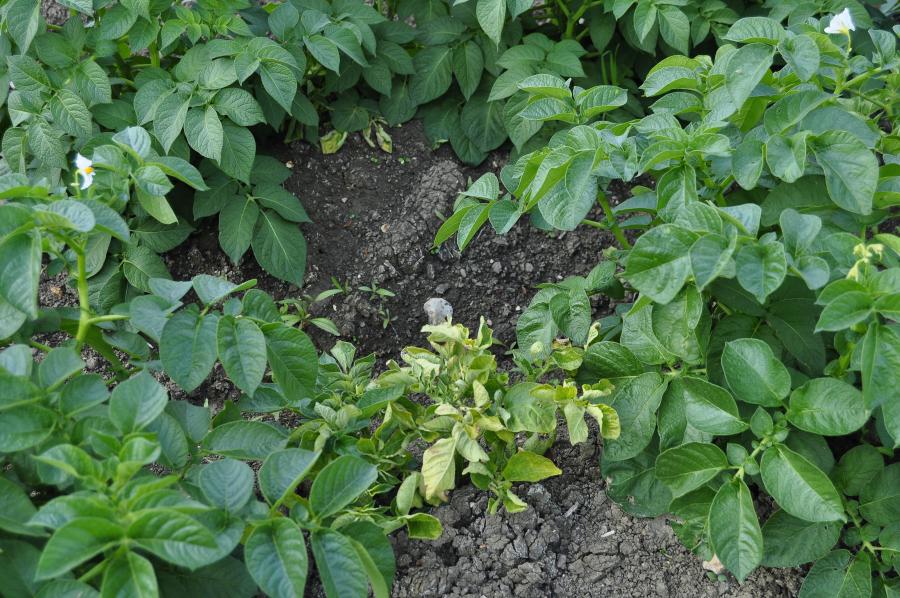
AHDB Potatoes presented what proved to be a popular technical event last week, which saw 60 growers and industry members from near and far attending an informal programme of technical talks and workshops, hosted by grower Gordon Rhind, at his family farm in Forres.
A Brechin-based seed grower himself, Alistair Melrose welcomed the grower gathering. Alistair set the scene by saying “Over the years, we have battled to control Blackleg with varying degrees of success. Undoubtedly, the weather has a major influence on the severity of the disease but as we cannot control this, we have to attempt to control the pathogen that causes the disease. To build our industry on repeat business both at home and abroad, good quality seed is essential.
Alistair continued “As the foundation of the whole process, it is vital that Pre-basic stocks are healthy. To that end, we are currently in the final year of a £300k research project into Blackleg co-funded by AHDB and Scottish Government. This project is focusing on Blackleg within the early seed generation, at PB level. We are fortunate today to have two of the main researchers involved in the project.”
Experts Gerry Saddler (SASA) and Ian Toth (James Hutton Institute), led the group through two linked Blackleg research projects they are undertaking on behalf of AHDB Potatoes and the Scottish Government with the early-generation seed industry. Their remit is to identify the sources of this damaging pathogen and what factors and changes in the industry are influencing the increase of blackleg occurrence.
Gerry, alongside Triona Davey (SASA), has been working on secondment with AHDB Potatoes looking at Blackleg management and he outlined work to date. Speaking to the growers, Gerry advised “Blackleg is a problem all over Northern Europe and it is by far the biggest reason for the downgrading and rejection of seed in this country. In Pre-Basic four crops (PB4), post-harvest surveys revealed that 100% of crops tested were infected with Pectobacterium atrosepticum, the Blackleg pathogen.
“We still don’t have all the answers and there is much ‘number-crunching’ still to do but what is becoming clear from our research is that there is no ‘silver bullet’ and the Blackleg problem needs to be tackled from several angles in conjunction.”
Ian Toth from the James Hutton Institute, involved in the research project, supported this approach. Ian stressed that we have to do something about Blackleg and although maybe we will never eliminate it, we need to look at how we can modify our practices as an industry to reduce incidences of this pathogen. Ian explained that the bacteria is very diverse and there are many routes for contaminants. For instance, by the 12-week stage, most of the infection is concentrated in the roots and tubers, so contaminated machinery might be playing a part in the spread.
Seed health needs to take all variables into account. Tactics such as separation of PB fields for years 1 and 2, isolation of PB fields from outside sources and diagnostic testing for contamination on the tuber surface and systemically are recommended. Ian went on to point out that it was important to ensure good drainage (high soil moisture levels have a negative effect) and to harvest your high-grade stocks as early as possible.
When asked by a grower if the project was “getting to the bottom of it”, Ian said that the research is proving valuable and that clues are emerging from the data as to what makes this organism so difficult to deal with. He agreed with Gerry’s points that it was clear that Blackleg needed to be tackled from several angles as problems can arise anywhere at any time so a multi-pronged approach will be most effective.
Host farmer, Gordon Rhind of Jas Rhind & Co, has three open-fronted ‘drying wall’ systems on his farm, each with modifications to suit the surroundings. Stuart Wale of SRUC took growers on a store tour around these positive ventilation drying systems to demonstrate how an effective drying system can minimise contamination by Blackleg bacteria.
“Imagine you’re a Blackleg microbe – what you love best is moisture and heat” advised Stuart, “Get your tubers dry quickly – and ventilate them for up to 7 days - and Blackleg bacteria will die much more rapidly. Immediately after harvest remove the field and respiration heat and you will prevent the moisture which develops from condensation. This stops the Blackleg bacteria multiplying and surviving. It’s not enough to just throw air at your tubers as it won’t reach crucial parts of the tuber or the whole store – positive ventilation systems are the best.”
This event was developed with the host farmer by AHDB Potatoes’ Technical Executive, Claire Hodge who is also working on the Blackleg research project. Claire commented “This meeting clearly demonstrated that industry are keen to learn more about what research is underway to understand Blackleg and even more importantly, what they can do to minimise Blackleg in their seed crops. This issue is not just important for the seed growers but for the whole of our industry and work will continue to try to understand the causes.”
